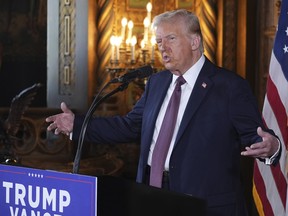In a press conference at his Mar-a-Lago resort in Florida on Tuesday, U.S. president-elect Donald Trump escalated his remarks about making Canada part of the U.S. He reiterated that he intends to put ‘substantial’ tariffs on goods from Canada and Mexico.
A Threat to National Security?
Asked if he would use military force to annex Canada, Trump replied ‘no — economic force.’ He claimed that using such a strategy would be beneficial for national security, citing the fact that the U.S. basically protects Canada. However, many experts have questioned the validity of this claim.
A Look at the Numbers
The total U.S. trade deficit in goods and services with Canada was US$40.6 billion in 2023, according to U.S. Census Bureau data. It’s driven by energy exports: the U.S. buys more than four million barrels a day of Canadian crude oil during some months.
A Poll on Canadian Sentiment
More than 80 per cent of Canadians are opposed to the idea of Canada becoming part of the United States, according to a recent poll. This is not surprising, given the cultural and economic differences between the two nations.
A Response from Prime Minister Trudeau
Prime Minister Justin Trudeau responded to Trump’s comments on X: ‘There isn’t a snowball’s chance in hell that Canada would become part of the United States.’ He also pointed out that workers and communities in both countries benefit from being each other’s largest trading partners.
An Examination of Export Taxes
In response to threats from Trump, officials in Ottawa have been examining the use of export taxes on items such as uranium, oil, and potash. These taxes could be used as potential responses in case there’s a trade war between Canada and the U.S.
The Impact on the Canadian Dollar
The Canadian dollar has dropped versus the greenback since Trump made a threat on Nov. 25 to put the tariffs on Canada and Mexico. The loonie was down 0.1 per cent to $1.4344 per US dollar as of 2:54 p.m. in New York.
A Resignation and a Leadership Vacuum
Trudeau announced his resignation on Monday, saying he doesn’t have enough support from within his Liberal Party to lead it into an election this year. This has created a leadership vacuum in Canada, with several potential contenders emerging as possible successors.
A Reaction from Conservative Leader Pierre Poilievre
Conservative Party Leader Pierre Poilieve has said that Canada would ‘never’ be a U.S. state. When asked about his comments on Tuesday, Trump responded: ‘Then maybe he won’t win. But maybe he will. Listen, I don’t care what he says.’
Conclusion
Trump’s threat of using "economic force" to try and annex Canada has sparked a reaction from both the Canadian government and opposition parties. While it remains to be seen how far Trump will go with this strategy, one thing is clear: the relationship between Canada and the U.S. is becoming increasingly strained.
Timeline of Events
- November 25: Trump threatens to put tariffs on Canada and Mexico.
- December 10: Trudeau announces his resignation as Prime Minister of Canada.
- December 11: Canadian officials begin examining the use of export taxes as a potential response in case of a trade war.
- December 12: The Canadian dollar drops versus the greenback.
What’s Next?
As the situation continues to unfold, it will be interesting to see how Trump follows through on his threat. Will he use "economic force" to try and annex Canada, or will he back down in the face of international pressure? Only time will tell.
References
- Bloomberg News: "Canada Examines Export Taxes as Trade War Looms"
- The Globe and Mail: "Trudeau Announces Resignation as Prime Minister of Canada"
- Reuters: "Canadian Dollar Drops Versus Greenback After Trump’s Tariff Threat"

